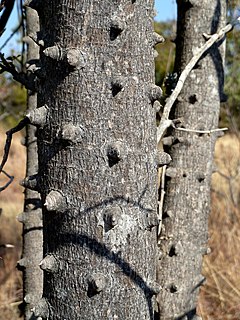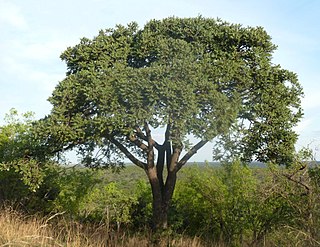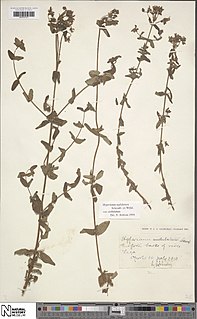
Hypericum is a genus of flowering plants in the family Hypericaceae. The genus has a nearly worldwide distribution, missing only from tropical lowlands, deserts and polar regions. Many Hypericum species are regarded as invasive species and noxious weeds. All members of the genus may be referred to as St. John's wort, and some are known as goatweed. The white or pink flowered marsh St. John's worts of North American and eastern Asia are now separated into the genus Triadenum.

Haworthia is a large genus of small succulent plants endemic to Southern Africa (Mozambique, Namibia, Lesotho, Eswatini and South Africa).

Clutia is a plant genus of the family Peraceae. It is native to sub-Saharan Africa and to the Arabian Peninsula.

Scadoxus puniceus, commonly known as the paintbrush lily, is a species of bulbous plant. It is native to much of southern and eastern Africa: Ethiopia, Sudan, Tanzania, Malawi, Mozambique, Zambia, Zimbabwe, Botswana, Eswatini (Swaziland), and South Africa. Scadoxus puniceus can be found in cool, shady habitat such as ravines and forests, where it is often found in moist leaf litter. Other common names include snake lily, royal paintbrush, King-of-Candida, African blood lily (English), rooikwas (Afrikaans), isisphompho, and umgola (Zulu). There are nine species of Scadoxus of which three, S. puniceus, S. multiflorus and S.membranaceus, occur in South Africa.

Capparis fascicularis, the zigzag caper-bush, is a plant in the Capparaceae family and is native to Africa.

Tragia durbanensis, the stinging nettle creeper, is a twining herb in the family Euphorbiaceae, with a restricted distribution in southern Africa. There are some 150 species in the genus Tragia.

Croton gratissimus, is a tropical African shrub or small tree with corky bark, growing to 8 m and belonging to the family of Euphorbiaceae or spurges. Young twigs are slender and angular and covered in silver and rust-coloured scales.

Zanthoxylum capense, the small knobwood, is a species of plant in the family Rutaceae. It occurs in the eastern regions of southern Africa, from the vicinity of Knysna, Western Cape to the Zimbabwean granite shield and coastal Mozambique. It tolerates a range of altitudes, from highveld to coastal elevations, but is most prevalent in dry thickets or on rocky slopes and outcrops.

The Knobbly fig is an African species of cauliflorous fig. It is named after Zanzibar, where Franz Stuhlmann discovered it in 1889. They often begin life as epiphytes, which assume a strangling habit as they develop. They regularly reach 10 m, but may grow up to 40 m tall as forest stranglers.

Lannea discolor, the live-long, is a plant species in the family Anacardiaceae. It is found from the DRC to Zambia, Zimbabwe, South Africa and Swaziland. It similar in appearance to L. schweinfurthii which has a largely overlapping distribution.

Combretum apiculatum is a species of tree in the family Combretaceae known by the common name red bushwillow. It is native to the mesic to semi-arid savanna regions of Africa, southwards of the equator.

Englerophytum natalense, the silver-leaf milkplum, is a medium-sized, evergreen tree that occurs along forested escarpments from East Africa to South Africa. The leaves are alternately arranged or spiralled, and to some extent crowded near the ends of branches. They are glossy green to greyish green above and covered in silvery hairs below. The stem is straight and the bark smooth. Young branches are covered with dense brownish hairs. The plant contains a milky latex.

Englerophytum is a group of trees in the family Sapotaceae described as a genus in 1914.

Euclea crispa, commonly known as the blue guarri, is an Afrotropical plant species of the family Ebenaceae. The hardy and evergreen plants may form a dense stand of shrubs, or grow to tree size. It is widespread and common in the interior regions of southern Africa, and occurs northward to the tropics. Though some are present near the South African south and east coasts, they generally occur at middle to high altitudes. It is readily recognizable from its much-branched structure and dull bluish foliage colour. Those bearing lanceolate leaves may however resemble the Wild olive, another common species of the interior plateaus.

Bonatea is a genus of orchids native to tropical and southern Africa, with one species extending into Yemen and Saudi Arabia.

Petalidium, commonly known as petal-bushes, is a genus of perennial shrubs in the acanthus family. They are native to sandy flats or stony slopes in the drier bush regions of Africa, India and the Mascarene Islands. The majority of species occur in frost-free, summer rainfall regions of southern Africa, and may be found from low to medium altitudes.

Hypericum canadense, known as Canadian St. Johns-wort, lesser St. John's wort, and lesser Canadian St. Johnswort, is a flowering plant in the genus Hypericum. It is a yellow-flowering annual or perennial herb native to North America and introduced to Ireland and The Netherlands. The specific epithet canadense means "Canadian".

Hypericum undulatum, the wavy St Johns Wort, is a herbaceous perennial flowering plant native to western Europe and northern Africa. The specific name undulatum is Latin, meaning "wavy" or "undulated", referring, just as the common name, to the wavy leaf margins of the herb. The plant has a diploid number of 16 or 32.

Protea burchellii, also known as Burchell's sugarbush, is a flowering shrub in the genus Protea, which is endemic to the southwestern Cape Region of South Africa.





















